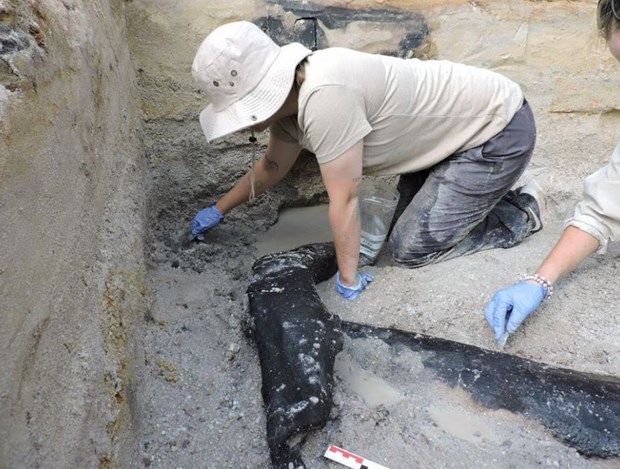Archaeologists have unearthed two large willow logs that were carved, shaped and joined together - the oldest specimens showing that ancient humans knew how to build structures from wood.
A log discovered at Kalambo Falls. (Source: Reuters)
Along the Kalambo River in Zambia, near the Kalambo Falls, the second highest in Africa, archaeologists have discovered traces of a wooden structure that may have existed nearly 500,000 years ago.
Archaeologists have unearthed two large willow logs that had been carved, shaped, and joined together. They are the oldest known examples of ancient humans building structures out of wood, a milestone in the skill that suggests our ancestors were more skilled than we thought.
Archaeologists believe the logs were carved with stone tools to form the framework of a wooden structure, a conclusion that contradicts the long-held notion that ancient humans were hunter-gatherers.
According to archaeologist Larry Barham from the University of Liverpool in England, the study's lead author, this could be part of a path or structure built above a marshy area, possibly a place to store firewood, tools, food or the foundation of a hut.
Working with wood requires not only skill but also appropriate tools and planning, suggesting that the person doing the work stayed in the same place for a long time, contrary to the traditional model of Stone Age humans as nomadic. Because it is difficult to collect ancient wooden artifacts because wood deteriorates over time, scientists still have little understanding of how ancient humans used this material.
According to study co-author Geoff Duller, from Aberystwyth University in Wales, most excavation sites from the same period usually only contain stone tools. Therefore, the site near Kalambo Falls provides unique evidence of wooden objects that ancient humans used stone tools to create, providing a more complete picture of human life at that time.
The oldest fossils of Homo sapiens found to date date back around 300,000 years. Wooden artifacts at Kalambo Falls have been dated to 476,000 years old.
Archaeologists have not found human fossils, but author Barham believes the artifacts were made by “Heidelberg Man,” a branch of Homo sapiens that existed between 700,000 and 200,000 years ago.
Of the two logs discovered at Kalambo Falls, the upper one is about 1.4m long and has a pointed tip. The lower one has only been excavated for about 1.5m. There are chisel marks on the two logs to fit the two together to form a stable structural frame. The two logs were found with their heads submerged, and the surrounding clay sediments were an oxygen-free environment that helped preserve the logs from deterioration over time.
The earliest known wooden artifact is a piece of plank found in Israel, which is about 780,000 years old. Wooden tools for foraging and hunting are known to date back about 400,000 years. A wooden tool dating back to the same age as the logs mentioned above has also been found at Kalambo Falls.
The excavation site, 400m upstream of Kalambo Falls, was discovered in 1953 but its exact age has not been determined. The new study used a method called luminescence dating, which measures how much energy an object has retained since it was buried.
Author Barham emphasizes that "the findings at Kalambo Falls indicate that these hominins, like Homo sapiens, were capable of modifying their surroundings, with skills in building structures. The use of wood in this way suggests that the cognitive abilities of these ancient hominins were greater than what scientists have long assumed based on stone tools.
According to Vietnam+
Source






























































































![[Infographic] In 2025, 47 products will achieve national OCOP](https://vphoto.vietnam.vn/thumb/402x226/vietnam/resource/IMAGE/2025/7/16/5d672398b0744db3ab920e05db8e5b7d)





Comment (0)